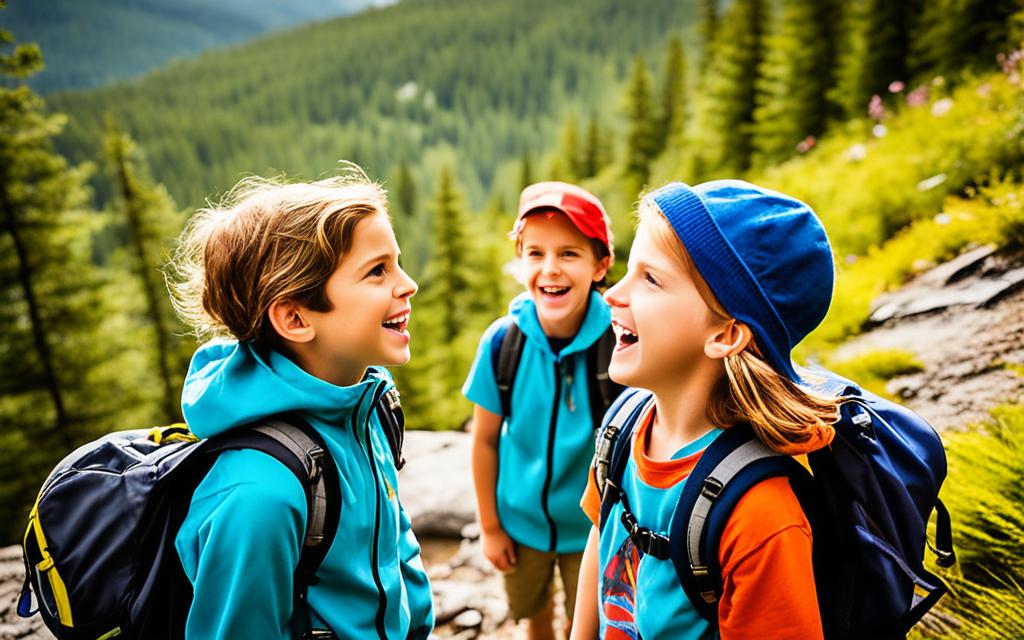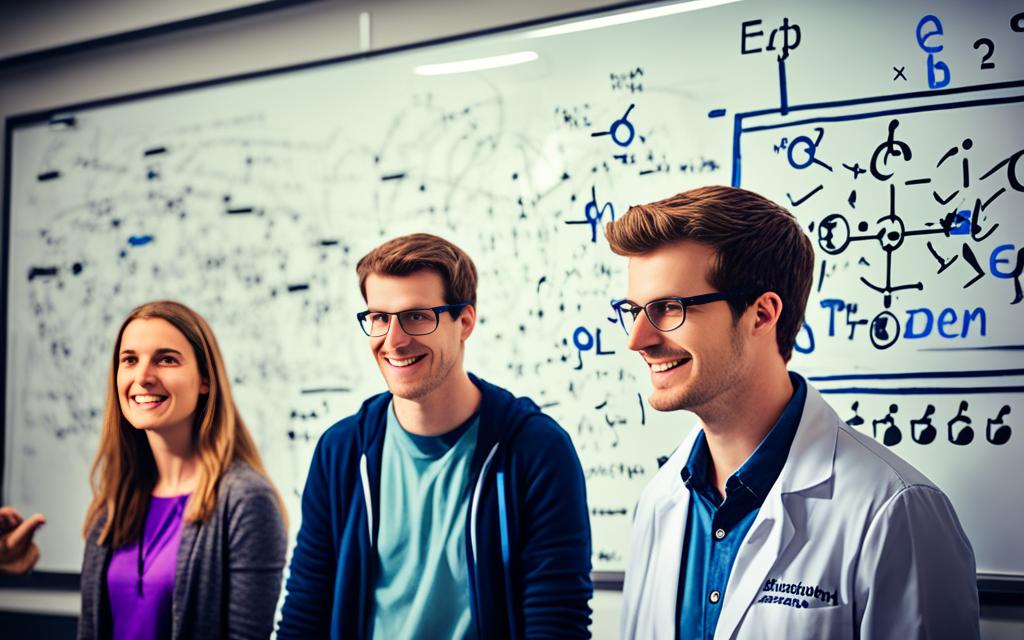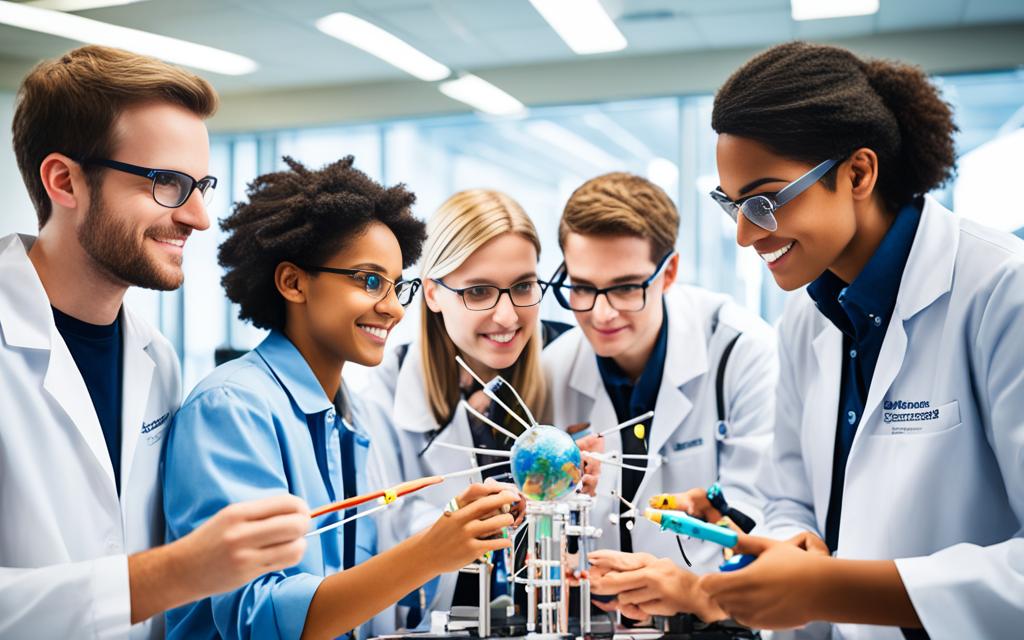In today’s fast-changing world, it’s more important than ever to inspire the next wave of scientists. Science helps us understand the world around us, from the smallest particles to the vastness of space. By cultivating an interest in science, we prepare young minds for the future through exciting experiments and hands-on learning.1
Key Takeaways
- Fostering curiosity in students is crucial for future scientists.
- Exciting methodologies engage students during experiments.
- These methods build essential critical thinking and problem-solving skills.
- Opportunities for hands-on exploration spark young minds.
- Guidance and support are vital for budding scientists.
Nurturing the Minds of Tomorrow
The Importance of Science Education
Science is all about understanding the world through tests and watching. It leads to new ideas and ways to compete globally. Science makes us move forward by finding new ways to battle diseases or studying space.2
Fostering Scientific Literacy and Curiosity
Getting students interested in science is key. It helps make the next group of scientists, engineers, and those who will create new things. By showing them fun ways to learn, teachers can spark their interest to dive deep into science and choose careers in STEM fields.23
In Southern California, there are many cool STEM programs after school, particularly in Los Angeles and Orange County.2 These activities help students learn about science, technology, engineering, and math in a fun way. They encourage kids to love these subjects and get curious about the world around them.
Kids who join these extracurriculars have done better in nationwide science and math tests than those who don’t. This was found by the National Science Foundation.2 It shows that getting students into science outside regular classes can really change their future for the better.
| Factors for Successful STEM Education | Findings |
|---|---|
| Instructor Qualifications | The teachers’ background is very important to how well students learn. They must know a lot about science and how to teach it.2 |
| Student-to-Teacher Ratio | It’s better when there are fewer students for each teacher in STEM. This way, teachers can help each student more and the students can work more together.2 |
| Access to Resources and Equipment | Having the latest tools and equipment is vital for learning real science. Good labs and new technology are needed for programs to do well.2 |
| Extracurricular Engagement | After-school STEM activities like competitions or community projects add a lot to learning. They provide more chances for students to enjoy and understand science.2 |
| Innovative STEM Programs | All Things Science is a special program that brings fun science learning to schools. It offers practical learning, great teachers, and is easy for students to join without extra travel.2 |
Engaging Teaching Strategies for Educators
Inspiring the next generation of scientists and innovators asks for catchy teaching methods. These should grab students’ attention and light a fire for learning. Nowadays, science teachers use many methods to do just that. They mix hands-on experiences with deep thinking to boost student interest and knowledge in science.1
Hands-on Experiments and Inquiry-Based Learning
Hands-on experiments bring the joy of science exploration right to the students. They learn by doing and figure out how things work through the scientific method. This method challenges them to solve the puzzles of each experiment.1 But there’s also inquiry-based learning. Here, students observe, investigate, and find knowledge on their own. It helps them develop their thinking and problem-solving skills.
Incorporating Technology in the Classroom
Bringing tech into the science class can pump up student interest and learning. Teachers use things like educational apps, Arduino kits, digital microscopes, and 3D printers. These give students hands-on and tech-filled experiences.1 Such modern tools not only hook students but also get them ready for the high-tech future.
Collaborative Learning and Gamification
Learning together in teams builds up student communication, critical thinking, and teamwork skills. It’s a win-win in science class.1 Adding game elements like digital simulations and educational games makes learning fun and hard to forget. These strategies play into students’ love for a challenge and competition.

Empowering Future Scientists
There’s a big need for scientists and innovators. America’s future relies on engaging science education. Through hands-on and interactive learning, teachers make science fun and interesting.4 Melyssa Ferro, a 2016 Idaho Teacher of the Year, believes this too. She says today students need to learn how to do science, not just memorize facts. For her, science is a doing word, not just a set of facts.4
More and more, high school students are diving into real scientific research. They work on projects with research papers, videos, and much more. A growing number even gets to publish their research in special journals for students.4 Taking part in things like reviewing others’ work helps these students feel like real scientists. It builds their confidence and sense of being part of the scientific community.4
A study recently looked at how teachers and scientists guide students. They were working on publishing their research. Mentors showed different ideas about how important publishing is for student scientists. They like to let students explore and learn on their own, helping them become independent thinkers.4 The study recommends that mentors should give students more support with writing about science. They could offer step-by-step help on how to write and publish research.4
Project-Based Learning and Real-World Applications
Getting students involved in exciting, hands-on learning helps them love and get better at science. Project-based learning (PBL) is a great way to do this. In PBL, students dive into complex real-world problems. They spend a lot of time working on these problems. This helps them learn a lot and improve their skills in critical thinking, solving problems, and talking about ideas.5
Solving Community Problems
PBL also lets students find and suggest answers to issues in their local area.5 When students take on real problems, they learn more about the scientific way of thinking. They also feel more responsible for their community and can actually help make things better.6
Classroom Gardens and Student-Led Initiatives
Imagine a classroom garden as another cool PBL project.5 Here, students are in charge of every step from planning to taking care of the garden. They learn about biology, ecology, and gardening by doing. This is called hands-on learning. There are also cool projects like making their own apps. These projects mix different subjects like science, technology, engineering, and math. They make learning fun and help kids be creative and solve problems.5
The Value of Field Trips and Interactive Experiences
Science education can be more than just class work. Field trips let students see science in the real world. These trips help students learn more deeply and get interested in science.7 By actually doing, students learn better, get more interested, and start noticing more about the world around them.7 They also become curious, learn to observe better, and get better at working with others. This makes them want to keep learning and helps their new knowledge fit with what they already know.7
Exploring Local Resources
Visiting a science center can be a fun, hands-on way for students to learn.7 They might even forget they’re in a class! If a science center isn’t an option, any place outside the classroom can lead to learning. This shows that science is all around us, not just in books.7
Inexpensive Science Field Trip Ideas
Some affordable science trips include visiting a water treatment plant to learn about clean water, a garden to see plants up close, or a natural body of water to study its life.78 Nature reserves are great for seeing animals and learning about nature. A local weather station can teach how we predict the weather.78
Research shows field trips can help a lot. They can make students do better in school for a while. Giving students time outside the school can improve their test scores, grades, attendance, and behavior.8 This effect is strongest in middle school and lasts for a few years.8
Adding field trips and hands-on learning to the class can really inspire students.78 It doesn’t have to be expensive. With local places and creative ideas, teachers can spark a love for science. They can help the next group of scientists and inventors get their start.

Building a Strong Foundation in STEM
The digital age is moving fast, showing us why STEM education matters more than ever. STEM (Science, Technology, Engineering, and Mathematics) subjects are the key to our modern world. They bring new ideas, boost our economies, and solve 21st-century problems.9
Interdisciplinary Approach to Learning
Teachers know that STEM fields are deeply connected. That’s why they mix different subjects to help students see the big picture. When students combine STEM subjects, they learn how their studies work together in real life.9 This makes them better at thinking critically, solving problems, and handling complex issues.
Developing Critical Thinking and Problem-Solving Skills
STEM doesn’t just teach facts; it builds skills that matter, like critical thinking and problem-solving. Students dive into real projects and coding, learning to apply creative thinking and analyze information. These skills are like gold in the job market and get students ready for any challenge ahead.9
With a solid STEM background, our young scientists and engineers can face the world’s big problems. They get the tools and knowledge needed to make a real difference.910
https://www.youtube.com/watch?v=RQmM7D4gGh4
Mentorship and Career Exploration
In scientific study, the relationship between a lab leader and their students is crucial. It greatly influences student growth and their future paths.11 Good mentors help shape new scientists. They give personalized guidance and support.11 This teamwork boosts creativity and problem-solving in research.11
Inspiring Young Minds through Role Models
Lab mentors help students see failure as a chance to grow.11 They push students to keep learning, making them lifelong knowledge seekers.11 These mentors carry a big role in the future of science. They promote self-responsibility, teamwork, and ongoing learning.11
Fostering Innovation and Entrepreneurial Mindset
Strong mentoring in science clues us in on early-career success. It boosts a scientist’s work and satisfaction, keeping burnout at bay.12 Effective mentoring means happier scientists, leading to better work and more success.12
Mentorship is good for everyone involved, allowing great science to blossom.12 Approaches like team mentoring offer fresh ideas, more responsibility, and a bigger professional circle for the ones learning.12 Recognizing the power of mentorship, institutions make it a must for science trainees to get funding.12
It’s vital for mentors to hone their skills. There are online courses and materials to help them do just that.12 Setting up clear goals and keeping open dialogue keeps mentorship strong.12

Community Outreach and Partnerships
Making strong links with the community is key in motivating future scientists and boosting scientific know-how. The NIH’s ComPASS program is set to design, spread, and check community-led health projects. Its goal is to cut down on health differences that hit racial and ethnic minorities and other groups harder. The program works to target the root social causes of poor health, including the lack of stable jobs, not enough good education, and unhealthy living conditions.13
Collaborating with Local Organizations
ComPASS aims to make science more diverse and bring it closer to the community by building trust and forming strong partnerships. It uses several strategies, such as Health Equity Research Hubs and the ComPASS Coordination Center. These efforts support local groups and help to share successful methods.13
Providing Academic Resources and Support
The NIH Community Engagement Alliance helps by providing online trainings and resources. These are aimed at aiding local groups and research teams with their grant applications and career growth. The program also listens to what the outside communities have to say through special meetings. This feedback helps shape the ComPASS program, approved by the NIH in January 2022.13
Science and community working together is vital. It improves locals’ access to crucial science info, spurring better solutions and protection. Yet, starting these partnerships is tough because scientists might lack public involvement skills. By sharing their knowledge and skills, scientists can truly support local groups by, say, crunching and presenting data together or assisting with funding requests.14
Good collaborations between scientists and communities help everyone. Scientists improve their research projects and get stronger community ties. For young scientists, these partnerships offer unique skills and show why their work matters to society. Talking openly about partnership goals is key in earning community trust.14

Cultivating a Love for Science
Most students and teachers agree that learning science should be exciting.15 Effective teaching methods can make the process enjoyable for both groups. Melyssa Ferro, 2016 Idaho Teacher of the Year, believes engaging students is key. She says, “Helping students see themselves as scientists changes everything. It’s not just reading. It’s about real-life applications.”15
Making Science Fun and Engaging
About 10 million students enter science fairs every year.15 These opportunities boost students’ interest and skills in science. Plus, they help create a positive view of science. Even students who might not usually get involved benefit. Making science captivating early on leads to continued interest in the subject.
Nurturing Lifelong Learners
Mentorship is crucial for underrepresented students in STEM fields.15 It significantly affects their future in science. Research mentors guide students through important practices like writing papers. These mentoring experiences are vital for deeper STEM engagement.
Teachers also play a big part in students’ STEM interests.15 Their teaching styles and the strategies they use can really make a difference. Getting students involved in real scientific practices can improve their literacy and build their identity within STEM subjects.15 Encouraging science early can lead to a passion that lasts a lifetime.
Conclusion
Nurturing the minds of tomorrow is complex, involving innovative teaching, hands-on learning, and mentoring. Nearly 10 million students join science fairs yearly, showing the great curiosity and potential of kids today. Mentors are key, especially for those not often seen in science, guiding students in STEM fields.15
Through promoting scientific literacy and critical thinking, educators lay a solid base for future science and tech leaders. Adding writing, peer-review, and publishing to the mix boosts students’ scientific understanding and self-confidence. Lab supervisors, with their accountability and growth mindset, greatly influence students’ lifelong love of learning.1511
The future really falls on the shoulders of teachers, mentors, and the community. Keeping them inspired and empowering the next science generation is our duty. This will encourage collaboration, innovation, and a true passion for science, unlocking our young people’s potential. Together, we can build a brighter future, rich in technology.11
FAQ
What is the importance of science education?
What are some effective student engagement strategies for science educators?
How can educators inspire and prepare students to pursue science in college and their careers?
What is the role of project-based learning in science education?
How can field trips and interactive experiences enhance science learning?
Source Links
- https://www.waldenu.edu/programs/education/resource/the-importance-of-learning-science-teaching-strategies-for-todays-educators
- https://www.atsclub.org/post/empowering-tomorrows-innovators-all-things-science-brings-stem-education-directly-to-southern-california-schools
- https://www.stjude.org/research/progress/2023/st-jude-mentors-nurture-tomorrows-scientists.html
- https://www.biorxiv.org/content/10.1101/2024.03.15.585231v1
- https://newtechnetwork.org/resources/what-is-pbl/
- https://yetiacademy.com/empowering-stem-education-through-project-based-learning-the-science-of-learning-by-doing/
- https://files.eric.ed.gov/fulltext/EJ1031445.pdf
- https://www.edutopia.org/article/yes-field-trips-are-worth-effort/
- https://www.linkedin.com/pulse/issue-8-stem-education-building-strong-foundation
- https://fossnextgeneration.com/building-the-future-with-stem-education/
- https://medium.com/mostly-about-science-mas/empowering-future-scientists-the-power-of-great-lab-supervision-e65623fba83e
- https://www.labmanager.com/the-value-of-mentorship-in-the-scientific-field-2937
- https://commonfund.nih.gov/compass
- https://www.ucsusa.org/sites/default/files/2023-10/SCP-2023.pdf
- https://www.biorxiv.org/content/10.1101/2024.03.15.585231v1.full
